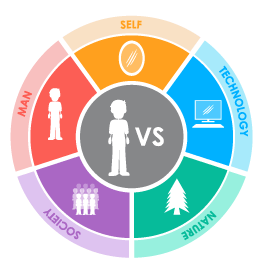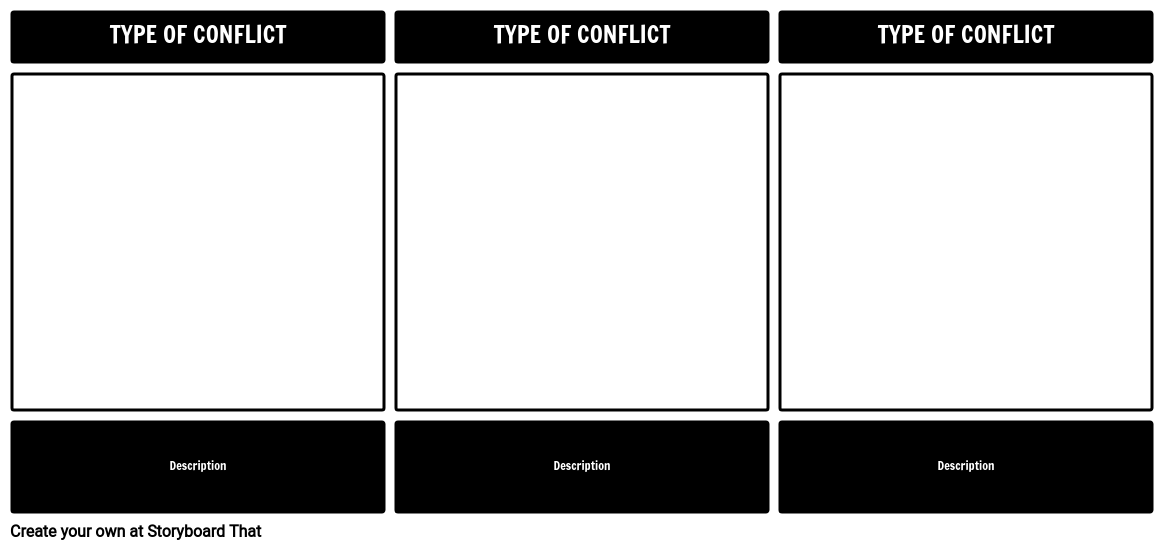Lesson Plan Overview
Literary conflicts are often taught during ELA units. Building on prior knowledge to achieve mastery level with our students is important. An excellent way to focus on the various types of literary conflict is through storyboarding. Having students choose an example of each literary conflict and depict it using the Storyboard Creator is a great way to reinforce your lesson!
Conflict between the A Midsummer Night’s Dream characters is an important recurring element. Much of the conflict that arises from the mismatched affections of the young Athenians, and from Puck's attempts to remedy the situation.
Examples of Conflict in A Midsummer Night’s Dream
MAN vs. SELF
In the beginning, Helena betrays her friend Hermia when she tells Demetrius that Hermia has run off with Lysander. Helena betrays her friend just to get closer to Demetrius, with whom she is in love, even though he does not reciprocate these feelings.
MAN vs. NATURE
Puck, as a faerie, and the Flower of Love, can both be seen as representing nature. Puck's mischief, and the fickle nature of love cause endless confusion among the mortals as they are controlled by the power of love.
MAN vs. MAN
Once Puck tries to "rectify" the situation, and both men to fall in love with Helena, the young Athenians are set against each other by jealousy. Hermia becomes livid with Helena for "taking" both of the men. Demetrius and Lysander are driven to the point of dueling over Helena.
Template and Class Instructions
(These instructions are completely customizable. After clicking "Copy Activity", update the instructions on the Edit Tab of the assignment.)
Student Instructions
Create a storyboard that shows at least three forms of literary conflict in A Midsummer Night’s Dream.
- Identify conflicts in A Midsummer Night’s Dream.
- Categorize each conflict as Character vs. Character, Character vs. Self, Character vs. Society, Character vs. Nature, or Character vs. Technology.
- Illustrate conflicts in the cells, using characters from the story.
- Write a short description of the conflict below the cell.
Lesson Plan Reference
Student Rubric
(You can also create your own on Quick Rubric.)
| Proficient | Emerging | Beginning | Try Again | |
|---|---|---|---|---|
| Conflict Identification | Student identifies correct major conflicts and uses strong, clear textual evidence to support choice. | Student identifies correct major conflict and uses few or unclear details to support their choice. | Student identifies incorrect major conflict, and uses some details from the text to support their choice. | Student does not attempt to identify major conflict or identifies incorrect major conflict with no explanation. |
| Understanding Outcome | Student clearly shows the outcome of the conflict and its effects on the protagonist with evidence from the text. | Student shows the outcome of the conflict and its effect on the protagonist, but some evidence is unclear. | Student shows the outcome of the conflict, but does not examine its effect on the protagonist and uses some vague textual evidence. | Student does not clearly show the outcome of the conflict or use textual evidence. |
| Character | Storyboard includes all required characters and clearly names them. Goes above and beyond by adding additional details. | Storyboard includes all required characters and clearly names them. | Storyboard includes protagonist and antagonist but leaves out other required characters. | Storyboard does not include the names of required characters. |
| Storyboard | Student clearly shows effort to convey the setting the scene of the book | Student attempts to convey setting and scene of the book, but lacks some clarity. | Student does not clearly convey the setting and scene. | Student makes little or no attempt to convey the setting or scene. |
| Spelling and Grammar | Student uses exemplary spelling and grammar. There are no errors. | Student makes a minor error in spelling and grammar. | Student makes several minor errors in spelling and grammar. | Student makes many errors in spelling and grammar; little attempt at spellchecking. |
Lesson Plan Overview
Literary conflicts are often taught during ELA units. Building on prior knowledge to achieve mastery level with our students is important. An excellent way to focus on the various types of literary conflict is through storyboarding. Having students choose an example of each literary conflict and depict it using the Storyboard Creator is a great way to reinforce your lesson!
Conflict between the A Midsummer Night’s Dream characters is an important recurring element. Much of the conflict that arises from the mismatched affections of the young Athenians, and from Puck's attempts to remedy the situation.
Examples of Conflict in A Midsummer Night’s Dream
MAN vs. SELF
In the beginning, Helena betrays her friend Hermia when she tells Demetrius that Hermia has run off with Lysander. Helena betrays her friend just to get closer to Demetrius, with whom she is in love, even though he does not reciprocate these feelings.
MAN vs. NATURE
Puck, as a faerie, and the Flower of Love, can both be seen as representing nature. Puck's mischief, and the fickle nature of love cause endless confusion among the mortals as they are controlled by the power of love.
MAN vs. MAN
Once Puck tries to "rectify" the situation, and both men to fall in love with Helena, the young Athenians are set against each other by jealousy. Hermia becomes livid with Helena for "taking" both of the men. Demetrius and Lysander are driven to the point of dueling over Helena.
Template and Class Instructions
(These instructions are completely customizable. After clicking "Copy Activity", update the instructions on the Edit Tab of the assignment.)
Student Instructions
Create a storyboard that shows at least three forms of literary conflict in A Midsummer Night’s Dream.
- Identify conflicts in A Midsummer Night’s Dream.
- Categorize each conflict as Character vs. Character, Character vs. Self, Character vs. Society, Character vs. Nature, or Character vs. Technology.
- Illustrate conflicts in the cells, using characters from the story.
- Write a short description of the conflict below the cell.
Lesson Plan Reference
Student Rubric
(You can also create your own on Quick Rubric.)
| Proficient | Emerging | Beginning | Try Again | |
|---|---|---|---|---|
| Conflict Identification | Student identifies correct major conflicts and uses strong, clear textual evidence to support choice. | Student identifies correct major conflict and uses few or unclear details to support their choice. | Student identifies incorrect major conflict, and uses some details from the text to support their choice. | Student does not attempt to identify major conflict or identifies incorrect major conflict with no explanation. |
| Understanding Outcome | Student clearly shows the outcome of the conflict and its effects on the protagonist with evidence from the text. | Student shows the outcome of the conflict and its effect on the protagonist, but some evidence is unclear. | Student shows the outcome of the conflict, but does not examine its effect on the protagonist and uses some vague textual evidence. | Student does not clearly show the outcome of the conflict or use textual evidence. |
| Character | Storyboard includes all required characters and clearly names them. Goes above and beyond by adding additional details. | Storyboard includes all required characters and clearly names them. | Storyboard includes protagonist and antagonist but leaves out other required characters. | Storyboard does not include the names of required characters. |
| Storyboard | Student clearly shows effort to convey the setting the scene of the book | Student attempts to convey setting and scene of the book, but lacks some clarity. | Student does not clearly convey the setting and scene. | Student makes little or no attempt to convey the setting or scene. |
| Spelling and Grammar | Student uses exemplary spelling and grammar. There are no errors. | Student makes a minor error in spelling and grammar. | Student makes several minor errors in spelling and grammar. | Student makes many errors in spelling and grammar; little attempt at spellchecking. |
How To Teach Literary Conflict in a Play
Explain Conflicts
As you begin to teach literary conflict, give students a full explanation of what to look for. Make sure to include Person vs. Person, Person vs. Self, Person vs. Nature, and Person vs. Society. Give examples from works students are familiar with to aid with learning.
Discuss Person vs. Person Conflicts
Discuss Person vs. Nature Conflicts
Because Puck is a fairy who loves to cause mischief and uses the elements of the natural world to do so, you can help students find many Person vs. Nature conflicts. He is always getting in the way of other characters, using potions and natural elements to do so.
Frequently Asked Questions about Depicting Literary Conflict in A Midsummer Night's Dream
Why are literary conflicts important?
Literary conflicts move the action of the story along and lead to the characters' interactions with each other. Without conflicts, nothing would really happen in the story.
How can using a storyboard help students understand literary conflicts?
Whenever students need to take the time to create pictures or write descriptions, they will be able to understand the story a little better. Using a storyboard helps students to organize their thoughts and their learning about literary conflicts.
What are the primary literary conflicts in A Midsummer Night's Dream?
One of the primary conflicts in this story is jealousy, or a person vs. person conflict. Hermia and Helena are mad at each other, while Demetrius and Lysander end up fighting over Helena. Person vs. Nature is also clearly scene with Puck (a fairy) using flowers and potions to go against the characters.
More Storyboard That Activities
A Midsummer Night's Dream
Testimonials

“By using the product, they were so excited and they learned so much...”–K-5 Librarian and Instructinal Technology Teacher

“I'm doing a Napoleon timeline and I'm having [students] determine whether or not Napoleon was a good guy or a bad guy or somewhere in between.”–History and Special Ed Teacher

“Students get to be creative with Storyboard That and there's so many visuals for them to pick from... It makes it really accessible for all students in the class.”–Third Grade Teacher
© 2026 - Clever Prototypes, LLC - All rights reserved.
StoryboardThat is a trademark of Clever Prototypes, LLC, and Registered in U.S. Patent and Trademark Office








